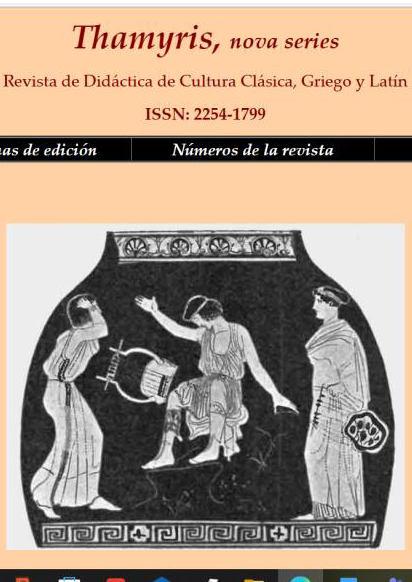Copistas medievales en latín de Educación Secundaria
DOI:
https://doi.org/10.24310/thamyristhrdcc.v13i16320Keywords:
Latin, didactic, writing, high schoolAbstract
In the present work, born with the intention of motivating students, we show an innovative experience developed in the Latin subject. In this activity, students become “medieval copyists” in order to create a Christmas greeting with aesthetics and content typical of that period. The activity initially focused on the content “writing systems and the Latin alphabet”, although it also served to work on other types of content
related to history, syntax and morphology that are inserted within the curriculum of the subject.
Downloads
Metrics
References
Codoñer, C. (2010) (coord.), La España visigótica y mozárabe: dos épocas en su literatura, Ediciones Universidad de Salamanca, Salamanca.
Díaz, E. (1859), Historia general de la Iglesia: Desde la predicación de los apóstoles hasta el pontificado de Gregorio XVI Vol. II, Imprenta de Ancos, Madrid.
García de Cortázar, J. A. & Teja, R. (2006) (coords.), Monjes y monasterios hispanos en la Alta Edad Media, Fundación Santa María la Real, Palencia.
Harris, D. (2013), Directorio de caligrafía. 100 alfabetos completos y cómo caligrafiarlos, Acanto, Barcelona.
Lillo Redonet, F. (2010), “Ampliando el corpus didáctico: textos latinos para Navidad y Reyes en Bachillerato y primeros años de universidad”, Thamyris 1, 23-41.
Reynolds, L. D. & Wilson, N. G. (1986), Copistas y filólogos, Gredos, Madrid.
Ruiz Elvira, E. (1988), Manual de codicología, Ediciones Pirámide, Madrid.
Velázquez Soriano, I. (1994), “Ámbitos y ambientes culturales en la Hispania visigoda. De Martín de Braga a Isidoro de Sevilla”, Augustinianum, 328-351.





